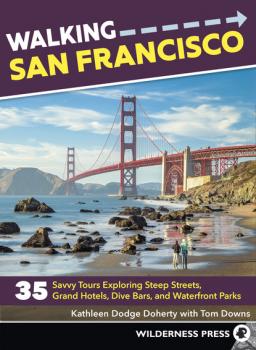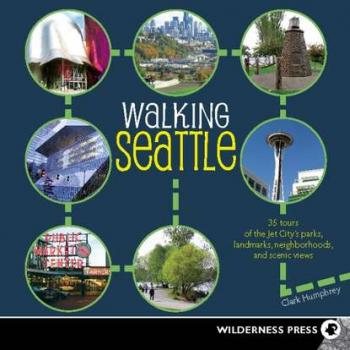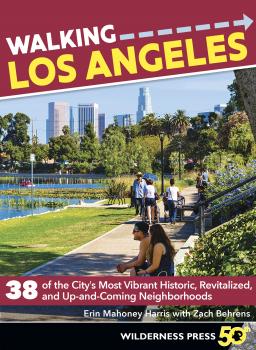ТОП просматриваемых книг сайта:
Walking
Скачать книги из серии WalkingАннотация
A new title in the Walking series, Walking: Salt Lake City is geared to first-time visitors to Salt Lake City–and to local residents. Both will enjoy the history and tales about places they thought they knew, and will be surprised to find walking destinations they may not have considered before.Each tour in the stylish, portable format touches on history, culture, and local architecture, plus insider recommendations on eateries, galleries, and nightlife. With clear maps depicting each walk, parking and public transit info, at-a-glance summaries and Points of Interest appendices, there's no better way to discover a city than on foot with a Walking guide.Walking Salt Lake City is a time-traveling guide to Salt Lake City's past and to its vibrant present. Written by Utah natives, it presents rambles of every kind. The 30+ tours explore the city's downtown, which is experiencing an invigorating renaissance; Temple Square, world headquarters of the Latter-Day Saints Church; Capitol Hill; character-filled neighborhoods like the Avenues and «15th and 15th»; and semi-rural surprises near and within the bustling city, from Memory Grove and City Creek Canyon, a stone's throw from metropolitan skyscrapers, to tucked-away and nearly forgotten Miller Bird Preserve and the appropriately named Hidden Hollow.While snow-capped mountains, famous canyon resorts, and the inland sea that gave the city its name invitingly beckon hikers, skiers, snowboarders, climbers, and day-trippers, Walking Salt Lake City unveils tempting reasons to enjoy the urban setting itself. Thoughtfully designed, the guide offers precise directions, easy to follow summaries, and tips about inviting eateries and shopping havens. Whether you are out for a heart-pumping workout or an evening stroll, filling an hour or a day, or count yourself a Utah visitor, a new resident or a lifelong local, this book is designed with you in mind.
Аннотация
Popular, proven format: the Walking series has sold more than 60,000 copies, strong numbers for city-specific titles Market: More than 40 million people went hiking/walking in the U.S. in 2016, with reasons ranging from enjoyment of the outdoors to health and exercise 35 featured walks, whether readers are looking for a 2-hour stroll or a full-day’s entertainment Now in full-color with a few new walking tours and revised routes Brand new format that’s even easier to use Photographs, maps, and need-to-know details like distance, difficulty, points of interest, and more The variety of walks helps people get out of their ruts and explore parts of the city they might not typically choose These walks connect—it’s easy to combine a few walks into a bigger adventure
Аннотация
Even though they're often lumped together, the Twin Cities are two distinct cities with very different histories. Minneapolis is the Mill City, the City of Lakes, composed mostly of flat prairies. St. Paul is the Capital City, built on rolling hills and high river bluffs.Culturally, the cities have their differences, too. Minneapolis is home to world-renowned theatres and modern art galleries, while St. Paul is the home of many of the state's institutions, from the seat of government to the seat of the Roman Catholic Archdiocese of St. Paul and Minneapolis. Minneapolis is a newer city, which is reflected in the architecture and overall vibe, while St. Paul's older neighborhoods feature some of the most intact Victorian-era houses in the country. Because of their locations on the west and east sides of the Mississippi River, critics say that Minneapolis is more like a modern West Coast city, while St. Paul is akin to a historic East Coast city.Both cities are linked by the Mississippi River–the same force that shaped their origins. St. Paul developed earlier, mostly because it was more easily accessible via the river. Another similarity between the two cities is the foresight by the Victorians who succeeded the cities' founders to invest money into their communities–both cities set aside large tracts of land for public use all along the rivers and lakes. Some of the most beautiful parks were plotted in the early days of the cities.Even today there are big differences between the cities. For example, St. Paulites, gluttons for punishment, host the annual Winter Carnival during the coldest time of the year. Minneapolitans take the easy way out by celebrating the Aquatennial Festival each summer. Despite having their city festivals at opposite ends of the solstice, Minnesotans love the outdoors. Even with the notoriously fierce winters, Minnesotans statistically spend more time outside than most.Whether you're interested in art, culture, history, or nature, there's a walk in this book designed for your interests. We hope that it serves not only as a guidebook for (re)discovering the Twin Cities, but as a springboard for additional explorations.This book contains 35 walks of varying levels of difficulty, built around the natural, architectural, and historical attractions of Minneapolis and St. Paul. The downtown areas of both cities are explored in depth, as well as many of the neighborhoods, scenic parks, and lakes that are scattered through the area.
Аннотация
Аннотация
Аннотация
Аннотация
Walking L.A. is your portable guide to 40 walking tours exploring historic stairways, hidden streets, public artwork, and architecture, much of which even lifelong Angelenos probably never even knew existed. Completely updated, the third edition of this award-winning book expands and improves upon most of the existing routes with completely revised points of interest, including brand-new trips to Palos Verdes Peninsula, Manhattan Beach, Highland Park, Mar Vista, and Downtown's Art District.This portable guide features detailed maps for each trip, original photos, and public transportation information. Route summaries make each walk easy to follow, and a «Points of Interest» section summarizes each walk's highlights, ranging from cultural institutions to the hippest spots to dine, drink, and shop.










